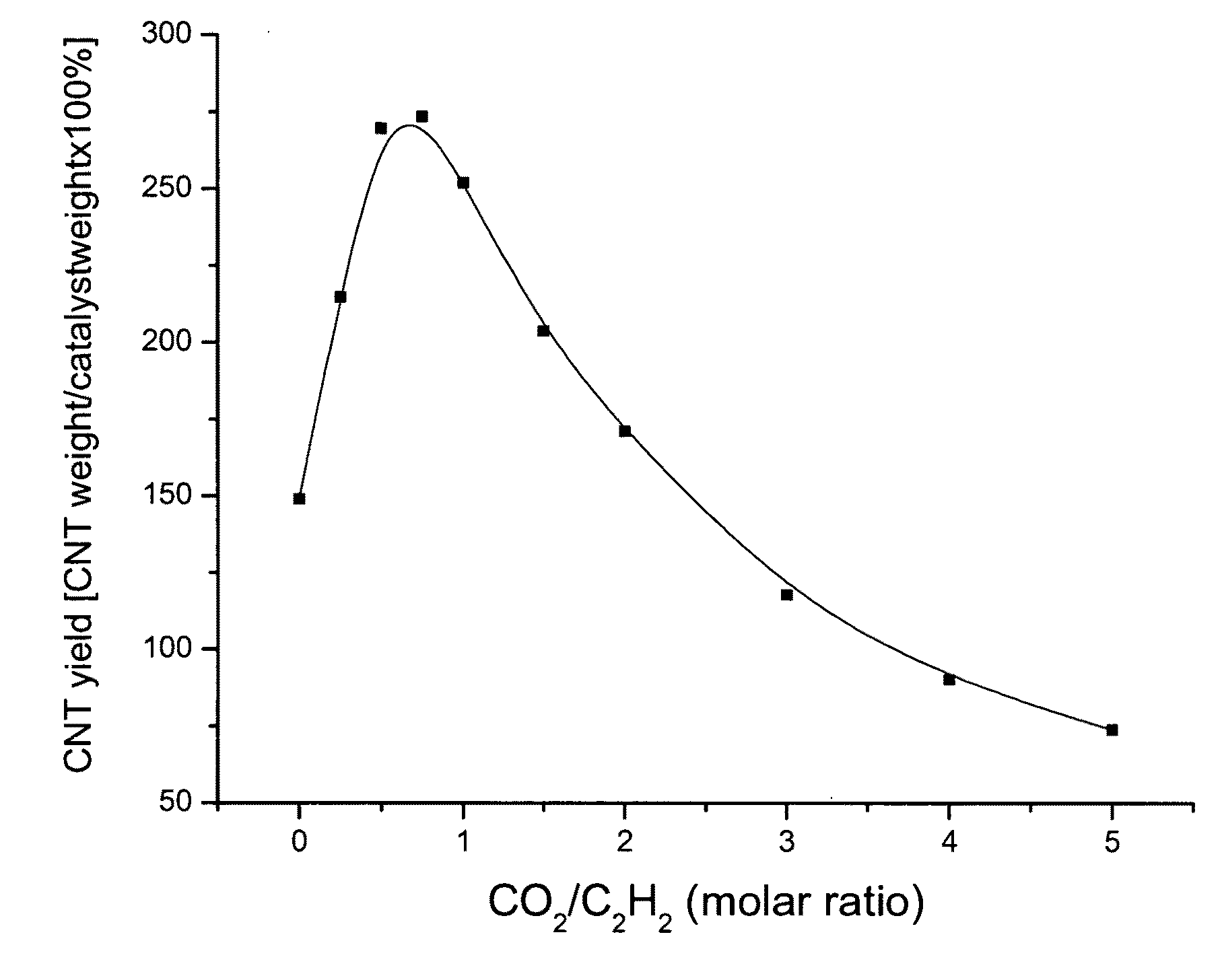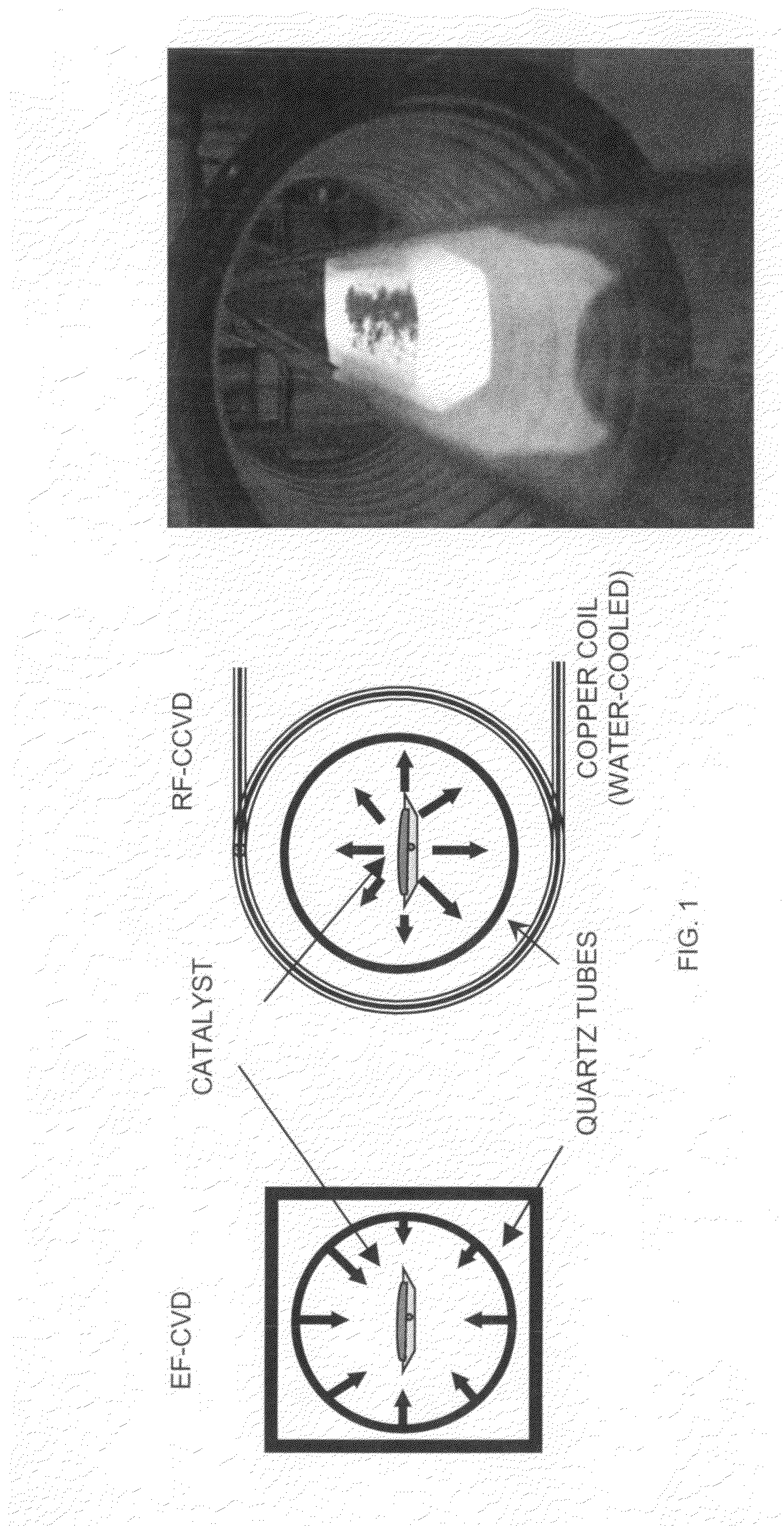Method for enhanced synthesis of carbon nanostructures
a carbon nanostructure and carbon nanotube technology, applied in the direction of carbonsing rags, metal/metal-oxide/metal-hydroxide catalysts, physical/chemical process catalysts, etc., can solve the problem of not having the quantity and form of carbon nanotubes and carbon nanofibers that are needed for practical applications, and achieve the effect of improving the yield of carbon nanotubes and nanofibers
- Summary
- Abstract
- Description
- Claims
- Application Information
AI Technical Summary
Benefits of technology
Problems solved by technology
Method used
Image
Examples
example 1
Growth and Harvest of SWNTs
[0038]Catalyst Preparation. Any catalyst known to those in the art can be used in the practice of the present invention. One such example is the following: A Fe—Mo / MgO catalyst was prepared by an impregnation method. An iron nitrate hydrate (Fe(NO3)3.9H2O) and ammonium molybdate ((NH4)6Mo7O24.4H2O) solution with MgO powder was ultrasonicated to a gel, dried at 383 K, ground to a fine powder, and then calcined at 823 K. The weight ratio of catalyst was 1:1:40 for Fe / Mo / MgO.
[0039]Synthesis of SWNTs. The synthesis of SWNTs at 1173 K performed with adding and not adding CO2 were compared. Around 200 mg of the catalyst was uniformly spread into a thin layer under nitrogen flow at 200 ml / min on a graphite susceptor and placed at the center of a quartz tube positioned horizontally inside an inductive furnace. After purging the system with nitrogen as carrier gas for 10 minutes, radio frequency (RF) heating at 350 KHz was applied to the graphite susceptor that con...
example 2
(A) Growth of MWNTs on Fe—Co / CaCO3 Catalysts
[0051]Fe—Co / CaCO3 catalysts. The stoichiometric composition of the catalyst was Fe:Co:CaCO3=2.5:2.5:95 wt %. First, the weighted amount of metal salts Fe(NO3)3.9H2O and Co(CH3COO)2.4H2O were dissolved into distilled water with agitation, and CaCO3 was added to the solution after the metal salts were completely dissolved. The pH-value of the mixture solution was adjusted to about 7.5 by dripping ammonia solution, in order to avoid the release of CO2 occurring when carbonates contact acids. Then, the water was evaporated with a steam bath under continuous agitation, and the catalyst was further dried at about 130° C. overnight.
[0052]Carbon nanotubes were synthesized on the Fe—Co / CaCO3 catalyst with cCVD approach using acetylene as carbon source. About 100 mg of the catalyst was uniformly spread into a thin layer on a graphite susceptor and placed in the center of a quartz tube with inner diameter of 1 inch, which is positioned horizontally i...
PUM
| Property | Measurement | Unit |
|---|---|---|
| temperature | aaaaa | aaaaa |
| temperature | aaaaa | aaaaa |
| temperature | aaaaa | aaaaa |
Abstract
Description
Claims
Application Information
 Login to View More
Login to View More - R&D
- Intellectual Property
- Life Sciences
- Materials
- Tech Scout
- Unparalleled Data Quality
- Higher Quality Content
- 60% Fewer Hallucinations
Browse by: Latest US Patents, China's latest patents, Technical Efficacy Thesaurus, Application Domain, Technology Topic, Popular Technical Reports.
© 2025 PatSnap. All rights reserved.Legal|Privacy policy|Modern Slavery Act Transparency Statement|Sitemap|About US| Contact US: help@patsnap.com



